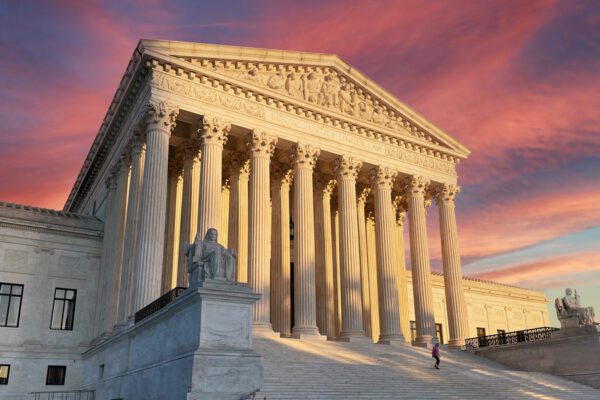During its 2023-24 term, the U.S. Supreme Court issued several important rulings that are expected to significantly affect employers. These cases addressed issues such as federal agency power, discrimination under Title VII of the Civil Rights Act (Title VII), whistleblower retaliation and arbitration.
The Court’s upcoming term, starting on October 7, 2024, will also include decisions on workplace-related cases covering topics such as the following:
- Employee misclassification – The court will decide the burden of proof employers must satisfy to establish an exemption from minimum wage and overtime requirements under the Fair Labor Standards Act (FLSA).
- Post-employment discrimination – The court will decide whether a former employee has the right to sue their former employer under the Americans with Disabilities Act (ADA).
2024-25 SCOTUS Cases
- E.M.D. Sales Inc. v. Carrera – The Supreme Court will decide the burden of proof employers must satisfy to establish an FLSA exemption.
- Stanley v. City of Sanford, Florida – The Supreme Court will decide whether a former employee has the right to sue their former employer under the ADA.
2023-24 SCOTUS Cases
- Muldrow v. City of St. Louis – The Supreme Court held that a job transfer may constitute illegal discrimination under Title VII.
- Loper Bright Enterprises v. Raimondo and Relentless Inc. v. Department of Commerce – The Supreme Court overturned Chevron deference, a doctrine that requires courts to defer to federal agencies when interpreting legal ambiguities.
- Murray v. UBS Securities LLC – The Supreme Court held that retaliatory intent is not required to prove whistleblower retaliation under SOX.
Action Steps
Employers should review the Supreme Court decision from last term, monitor for updates on decisions from this upcoming term and familiarize themselves with the potential outcomes and implications of each case.
2024-25 SCOTUS Cases to Monitor
Employee Misclassification – E.M.D. Sales Inc. v. Carrera
Legal Question
On Nov. 5, 2024, the Supreme Court is scheduled to hear oral arguments in E.M.D. Sales Inc. v. Carrera, a case in which the Supreme Court will decide what evidence an employer needs to show to prove it correctly classified employees as exempt from minimum wage and overtime pay under the FLSA. The Supreme Court’s ruling will address a disagreement among federal appeals courts on the issue.
Case Summary
Under the FLSA, covered employers must pay employees at least the federal minimum wage for all hours worked and overtime at a rate of 1.5 times their regular rate of pay for all hours worked over 40 hours in a work week. However, the FLSA provides several exemptions from minimum wage and overtime pay requirements. The most common are “white-collar” exemptions, which mainly apply to executive, administrative and professional employees but also include outside sales personnel and certain computer and highly compensated employees. Employers carry the burden of proving proper employee classification under the FLSA.
In E.M.D. Sales Inc., employees of a grocery distribution company claimed they were misclassified as exempt outside sales employees and, as a result, were owed overtime pay. The company argued before the District Court that the employees were exempt from overtime because they were outside sales personnel. The District Court rejected the company’s argument, holding that the company had failed to establish that the employees’ primary duty was making sales. On appeal, the company argued that the District Court erred in requiring it to establish the employees’ primary duty by “clear and convincing” evidence rather than a “preponderance of the evidence.” The 4th Circuit Court of Appeals affirmed the District Court’s decision.
Under the preponderance of evidence standard, employers must show that it is more likely than not that an employee is exempt under the FLSA. This is a lower evidentiary standard than the “clear and convincing” evidence standard, which requires employers to show more substantive evidence (e.g., that is far more likely) to prove that an employee is exempt. In E.M.D. Sales, Inc., the employer argued that the “clear and convincing” standard is an unusually heavy burden reserved for weighty matters, such as civil commitment, termination of parental rights and deportation, and not for determining FLSA exemptions. However, the 4th Circuit applied the “clear and convincing” standard. In doing so, it is the sole federal appeals court to apply this standard. The 5th, 6th, 7th, 9th 10th and 11th Circuits have applied the “preponderance of evidence standard.”
Potential Employer Impact
The holding in E.M.D. Sales Inc. will likely have a significant impact on employers determining whether to classify their employees as exempt or nonexempt under the FLSA. If the Supreme Court adopts the higher “clear and convincing” evidence standard, employers will face a much higher bar when defending against FLSA misclassification claims. However, even if the Supreme Court decides to implement the preponderance of the evidence standard, making it easier for employers to prove FLSA exemptions, proper employee classification will likely remain a compliance burden for employers. Improper classification can result in significant penalties and costly litigation. To mitigate the risk of employee misclassification, covered employers can review the FLSA’s duties tests for all exemptions to ensure employees are properly classified, promptly correct any errors, and update job descriptions to reflect employees’ roles and responsibilities accurately.
ADA Post-employment Discrimination – Stanley v. City of Sanford, Florida
Legal Question
On June 24, 2024, the Supreme Court granted certiorari in Stanley v. City of Sanford, Florida, to address a circuit split as to whether a former employee, who was qualified to perform their job and earned post-employment benefits while employed, has the right to sue their former employer under the ADA’s antidiscrimination provision with respect to those benefits when they are no longer employed.
Case Summary
The ADA protects the rights of individuals with disabilities and prohibits discrimination in various areas, including employment. Under the ADA, employers with 15 or more employees are prohibited from discriminating against qualified applicants and employees with disabilities in all employment practices, including terms, conditions and privileges of employment. This includes fringe benefits, such as health insurance.
In Stanley, a former city firefighter with Parkinson’s disease took disability retirement. The plaintiff received approximately $1,000 per month in benefits as part of their disability retirement package, and the city paid their health premiums. Under the health plan in effect when the plaintiff joined the city fire department, employees retiring for qualified disability reasons received free health insurance until age 65. However, the city revised its disability retirement health insurance while the plaintiff was still employed. Under the new plan, disabled retirees only received health insurance for two years after retiring. After retiring, the plaintiff sued their former employer, claiming the city’s decision to reduce their health insurance subsidy was discriminatory against them as a disabled retiree.
Both the District Court and 11th Circuit held that the plaintiff could not sue their former employer under the ADA for loss of a health insurance subsidy because they were no longer a city employee, reasoning that the ADA only prohibits discrimination against individuals who hold or desire to hold a job. The 6th, 7th and 9th Circuits have ruled the same way in similar lawsuits brought by former employees claiming ADA discrimination. However, the 2nd and 3rd Circuits have held that the ADA’s antidiscrimination provision is ambiguous and resolved that ambiguity in favor of former employees.
Potential Employer Impact
A ruling in the plaintiff’s favor would resolve the circuit split and expand the scope of actionable claims under the ADA by allowing former employees to sue their former employers. Consequently, employers may consider ensuring that their employment-related decisions and policies that potentially impact retirees are not based on discriminatory motives. For example, employers could ensure that changes to health care plans that include retirees are based on objective, nondiscriminatory criteria.
2023-2024 SCOTUS Decisions
Title VII Discriminatory Transfers – Muldrow v. City of St. Louis
Holding
On April 17, 2024, the Supreme Court unanimously held in Muldrow v. City of St. Louis that employees do not need to suffer “significant” harm to state a claim for discrimination under Title VII. Instead, plaintiffs alleging Title VII discrimination must show they suffered “some harm” regarding an identifiable term or condition of employment.
Case Summary
Title VII makes it unlawful for an employer “to fail or refuse to hire or to discharge any individual, or otherwise discriminate against any individual” with respect to “compensation, terms, conditions or privileges of employment” on the basis of race, color, religion, sex or national origin (referred to as protected characteristics). Circuit courts have disagreed on whether a forced job transfer may be unlawful discrimination even if the transfer does not significantly disadvantage the employee (e.g., does not result in lower compensation or a loss of professional opportunities).
In Muldrow, the plaintiff was a female St. Louis Police Department officer. After working for years in the same position, she was forced to transfer to a different division but retained the same compensation and title. Following her transfer, her employer placed a male officer in her previous position. Although her transfer did not result in any change to her pay or rank, the plaintiff alleged that she was subject to a discriminatory job transfer because of her gender. The District Court and 8th Circuit held in favor of the defendant, stating that the plaintiff’s transfer did not violate Title VII because she did not suffer any material employment disadvantage.
The Supreme Court held that to establish a Title VII discrimination claim, a plaintiff must show some harm respecting an identifiable term or condition of employment. Requiring the harm to be “significant” would impose a new requirement under Title VII. The Supreme Court found that the plaintiff established “some harm” when she was transferred because she was moved from a plainclothes job in a prestigious specialized division to a uniformed job supervising the day-to-day activities of neighborhood patrol officers (resulting in the plaintiff being less involved in highly visible matters and primarily performing administrative work), her schedule became less regular (often requiring her to work on weekends) and she lost her take-home car. The Supreme Court determined that it did not matter that the plaintiff’s rank and pay remained the same or that she could still advance to other positions. The Supreme Court vacated the 8th Circuit decision and remanded the case for further proceedings.
Employer Impact
The holding in Muldrow resolved the circuit split and expanded the scope of actionable claims under Title VII by prohibiting job transfer based on an employee’s protected characteristic that result in some harm. As a result, employers may consider greater care when mandating employee transfers, including lateral job transfers, to ensure that such decisions are not discriminatory. For example, employers could consider revising existing transfer policies to ensure any decisions are based on objective, nondiscriminatory criteria and that such criteria are appropriately documented.
Notably, while the plaintiff argued that any personnel decision based on an employee’s protected characteristic is discriminatory, the Supreme Court limited the scope of the case to job transfers. Therefore, the Supreme Court’s decision is unlikely to affect other employment actions.
Chevron Deference – Loper Bright Enterprises v. Raimondo and Relentless Inc. v. Department of Commerce
Holding
On June 28, 2024, the Supreme Court decided two cases, Loper Bright Enterprises v. Raimondo and Relentless Inc. v. Department of Commerce. In doing so, it overturned its 1984 decision in Chevron, U.S.A. Inc. v. Natural Resources Defense Council Inc., which held that courts should defer to federal agencies to interpret ambiguities and gaps in the laws that the agencies implement (known as Chevron deference).
Case Summary
Congress has the authority to pass laws that govern employers, and federal agencies have the authority to enforce those laws. To fill in any gaps or to remedy any ambiguities, federal agencies may issue more detailed guidance on how the laws should be interpreted and applied. For example, agencies may publish informal guidance, issue opinions or publish formal regulations. Under the doctrine of Chevron deference, courts were directed to defer to such agency guidance where the statute was ambiguous and the agency’s interpretation was reasonable.
In a 6-3 decision, the Supreme Court overturned the longstanding Chevron deference doctrine in Loper and Relentless. The Supreme Court held that courts may not defer to a federal agency’s interpretation of the law just because a law is ambiguous. Instead, courts must exercise independent judgment when deciding whether a federal agency has acted within its statutory authority. The Supreme Court reasoned that the Chevron holding was inconsistent with the requirements of the Administrative Procedure Act since it permitted federal agencies to change positions without Congress authorizing them to do so.
Employer Impact
The Loper and Relentless ruling is unlikely to have an immediate impact on employers. However, Chevron deference has a meaningful influence on the interpretation and enforcement of labor and employment laws. Federal employment agencies, including the U.S. Equal Employment Opportunity Commission, OSHA, the U.S. Department of Labor (DOL) and the National Labor Relations Board, have relied on Chevron deference in issuing and defending agency interpretations. However, by ending Chevron deference, courts are now required to exercise independent judgment when reviewing agency action. If a law is ambiguous, courts will decide whether an agency acted within its statutory authority. Federal agencies will no longer be able to rely on Chevron deference in existing litigation, including lawsuits that have been filed to challenge the DOL’s independent contractor rule and overtime rule because the Supreme Court overruled Chevron. Additionally, federal agencies may be subject to additional legal challenges to existing rules. This may result in federal agencies issuing fewer regulations and taking more moderate positions in the regulations they issue.
As a result of the Loper and Relentless ruling, employers will likely need to prioritize staying informed of potential lawsuits addressing federal agencies’ interpretations of labor and employment laws. These lawsuits may result in a patchwork of compliance obligations for employers, as it’s likely that judges in different jurisdictions will make different, even contradictory, rulings on the same issue. This will likely increase the compliance burden of multistate employers. To prepare for these anticipated lawsuits, employers can review their practices and policies that rely on administrative rules and guidance and prepare for potential changes to those rules and guidance. Moreover, in response to the Loper and Relentless ruling, federal agencies may prioritize enforcement actions. Therefore, employers may consider taking action now to ensure that they are complying with federal labor and employment laws.
Whistleblower Retaliation – Murray v. UBS Securities LLC
Holding
On Feb. 8, 2024, the Supreme Court unanimously held in Murray v. UBS Securities LLC that whistleblower employees do not need to prove that their employer acted with retaliatory intent to be protected under the federal whistleblower protections of the Sarbanes-Oxley Act (SOX).
Case Summary
SOX prohibits publicly traded companies from discharging, demoting, suspending, threatening, harassing or otherwise discriminating against employees in retaliation for reporting fraud or violations of federal securities laws and regulations (i.e., engaging in protected activity).
In Murray, the plaintiff alleged that his former employer violated SOX by terminating his employment after he raised concerns about potentially unethical and illegal activity. The 2nd Circuit ruled in favor of the employer, holding that an employee must prove that the employer acted with retaliatory intent to prove a whistleblower claim. The 2nd Circuit decision deviated from holdings in other circuits, which have held that evidence of retaliatory intent is not required.
On appeal, the Supreme Court reversed the 2nd Circuit decision and resolved the circuit split by establishing that a plaintiff only needs to prove that the whistleblowing activity was a “contributing factor” in the unfavorable personnel decision but does not need to prove that the employer acted with retaliatory intent. If the employee may make that showing, the employer must demonstrate that it would have taken the same action if the employee had not engaged in whistleblowing activity.
Employer Impact
The holding in Murray may make it easier for employees to meet their burden of proof in SOX whistleblower retaliation cases and place a greater onus on employers to prove that they would have taken the same action regardless of the whistleblowing activity. To mitigate the risk of whistleblower retaliation, covered employers may consider reviewing their existing policies and procedures to ensure that employee concerns are properly addressed and investigated, implementing and enforcing a robust anti-retaliation policy and training protocol, ensuring that any adverse actions are made for legitimate nonretaliatory reasons and properly documenting such reasons.
Material posted on this website is for informational purposes only and does not constitute a legal opinion or medical advice. Contact your legal representative or medical professional for information specific to your legal or medical needs.



